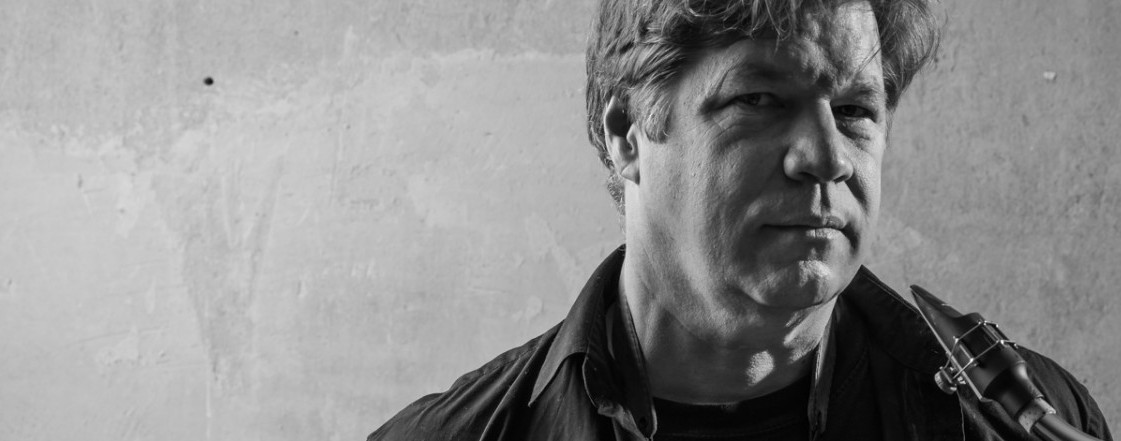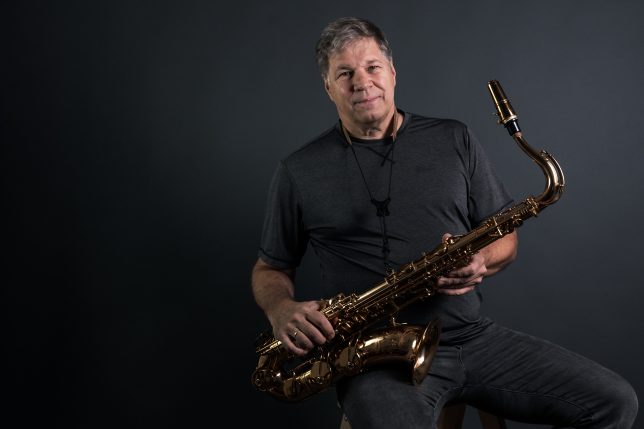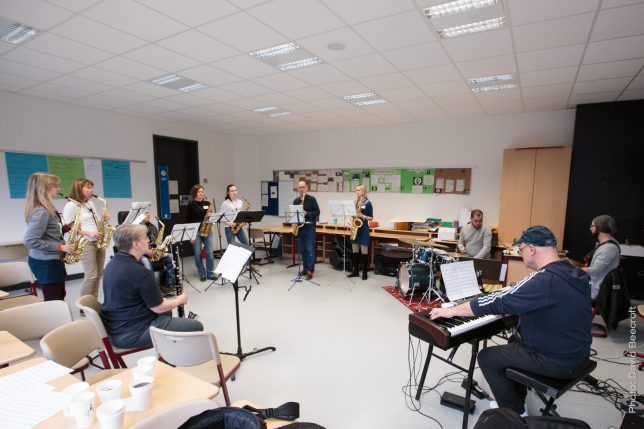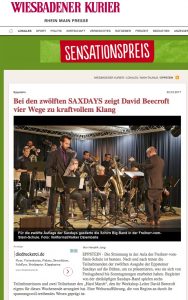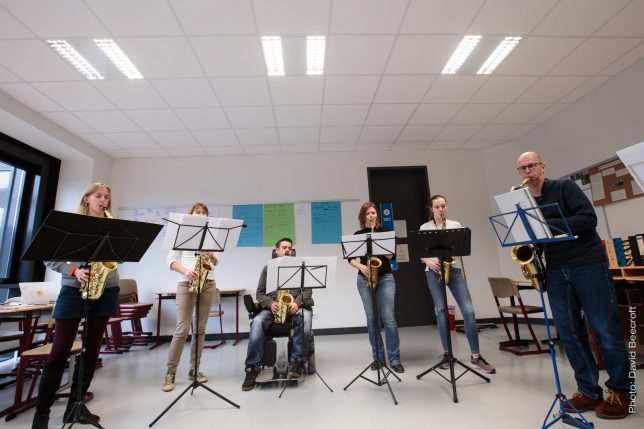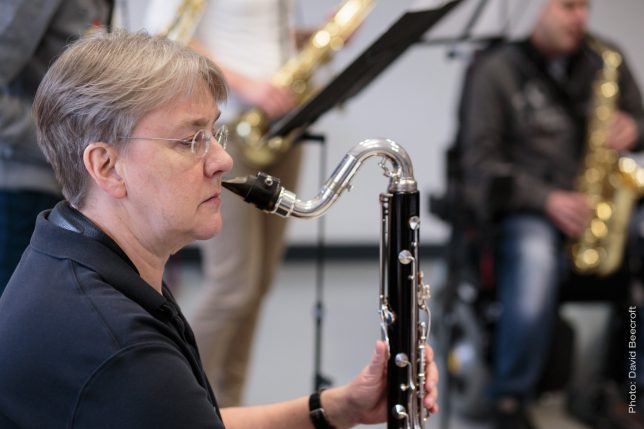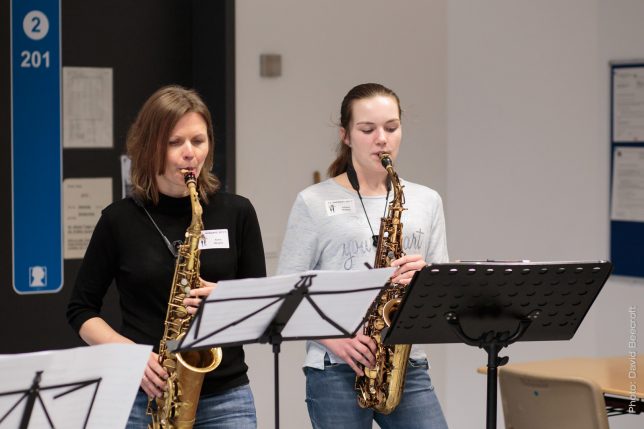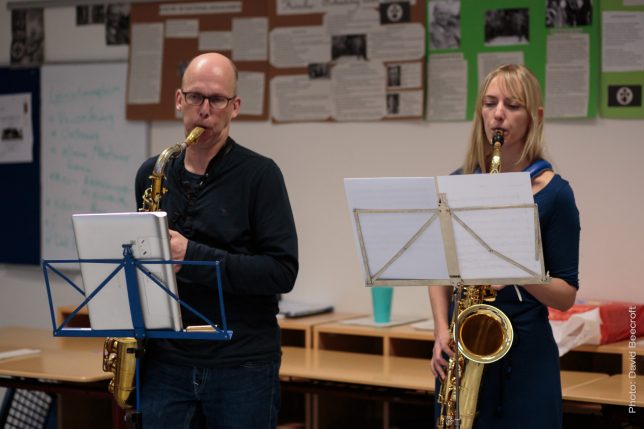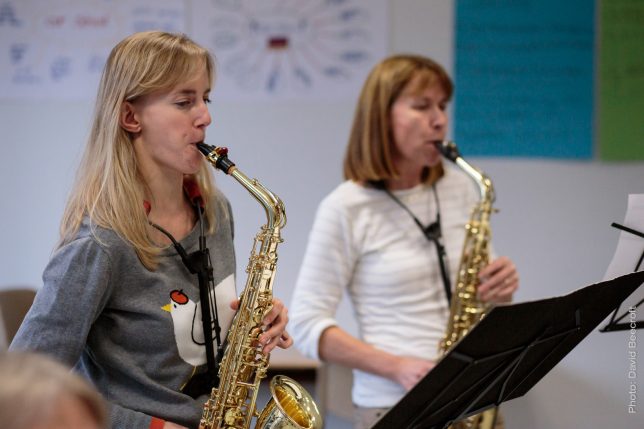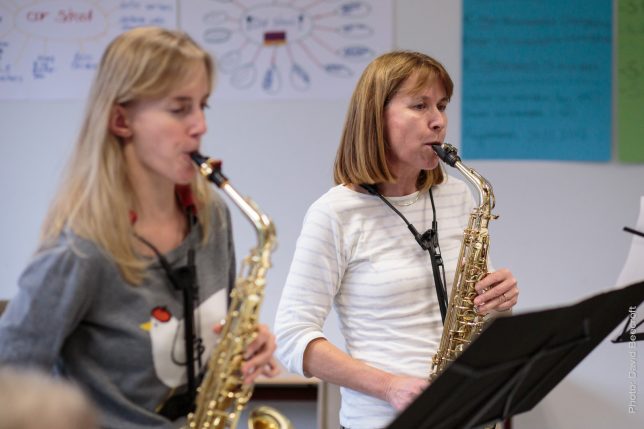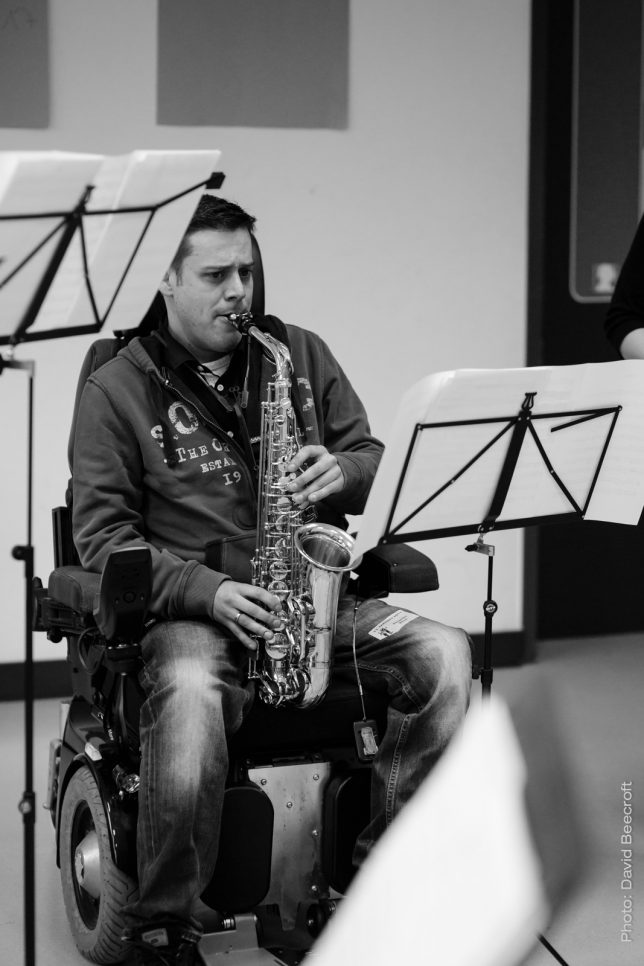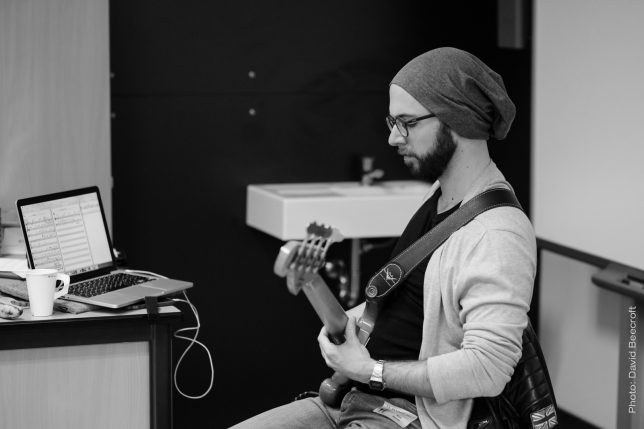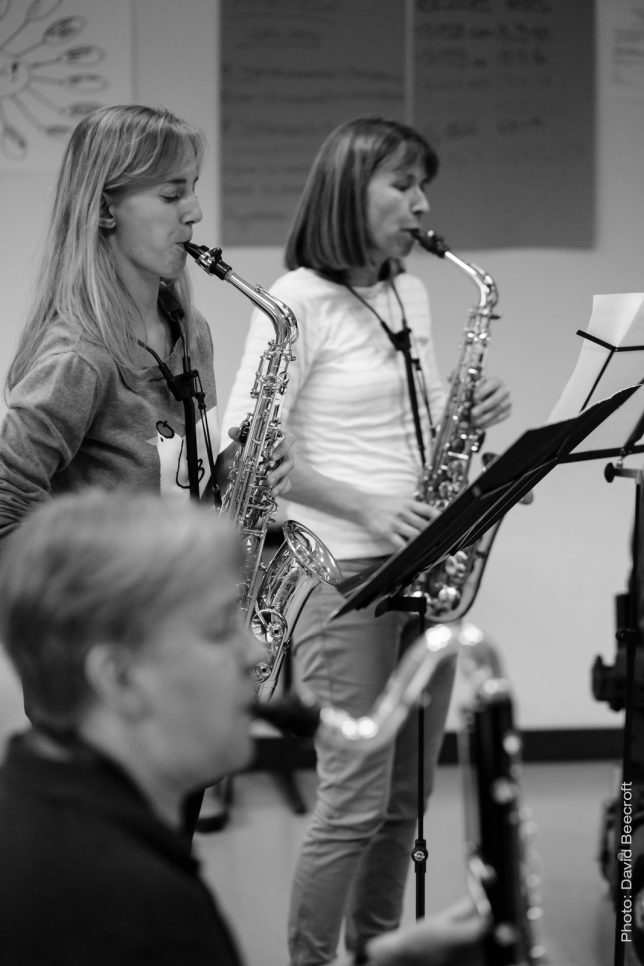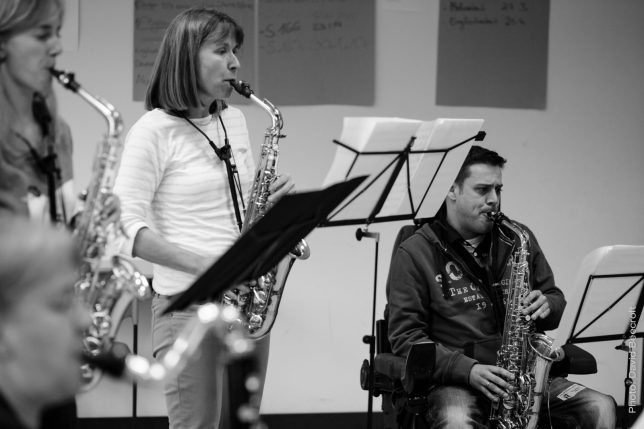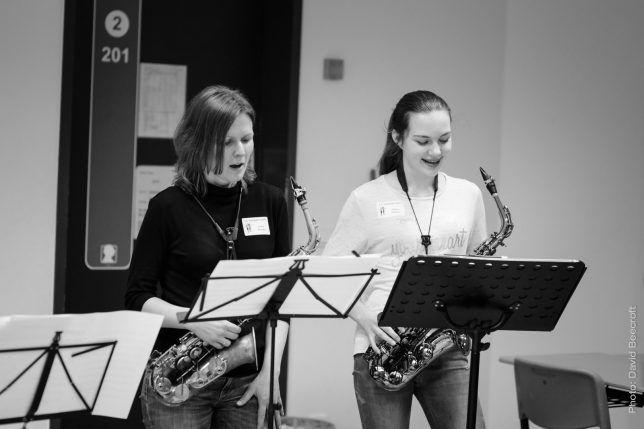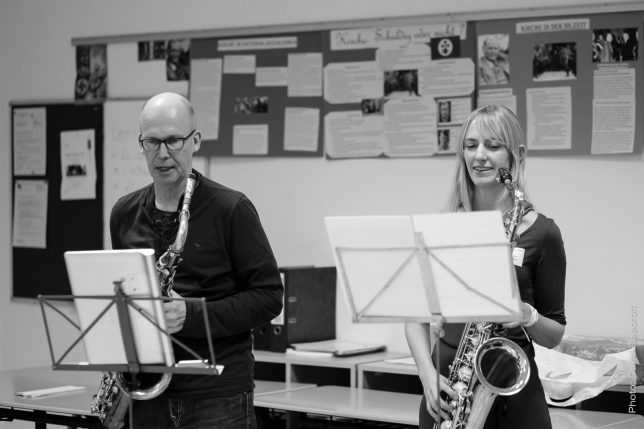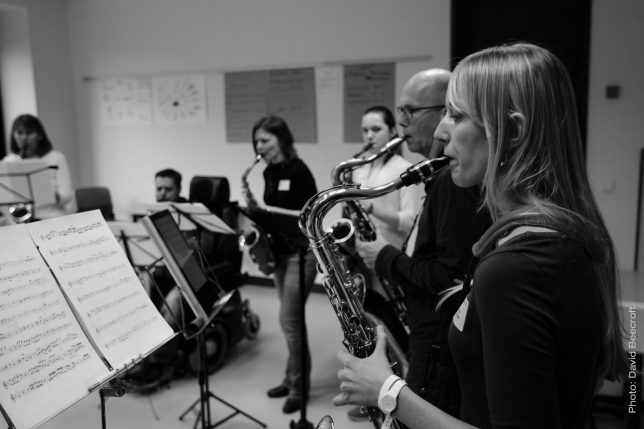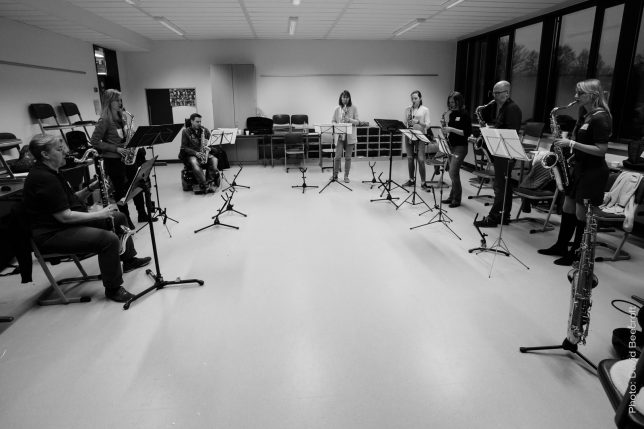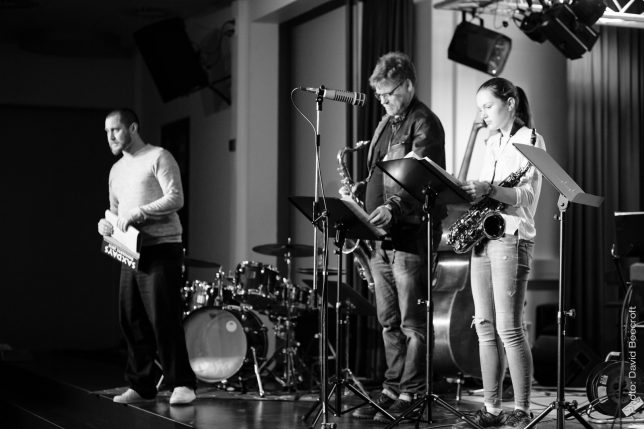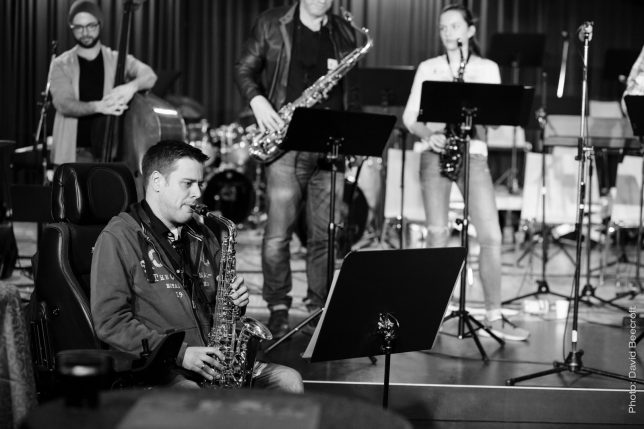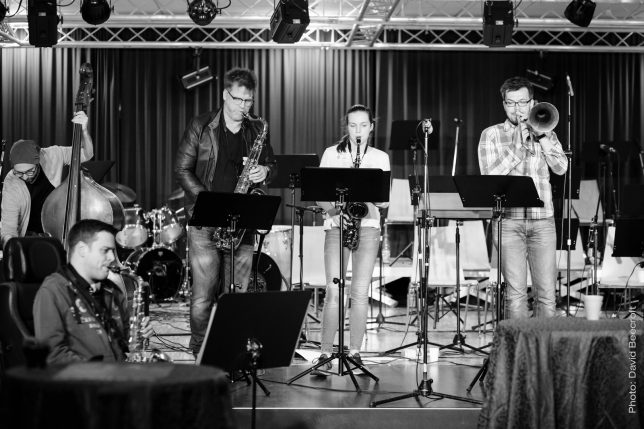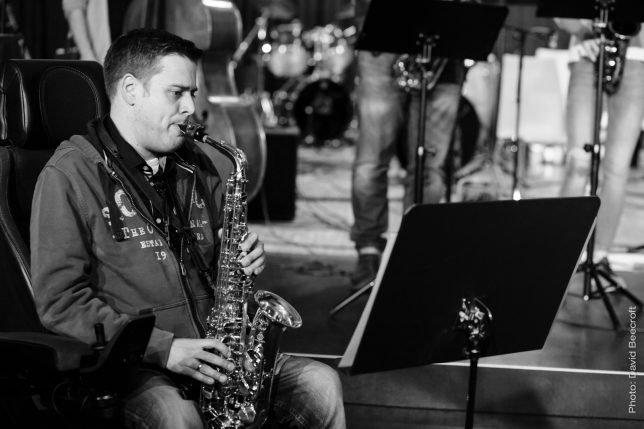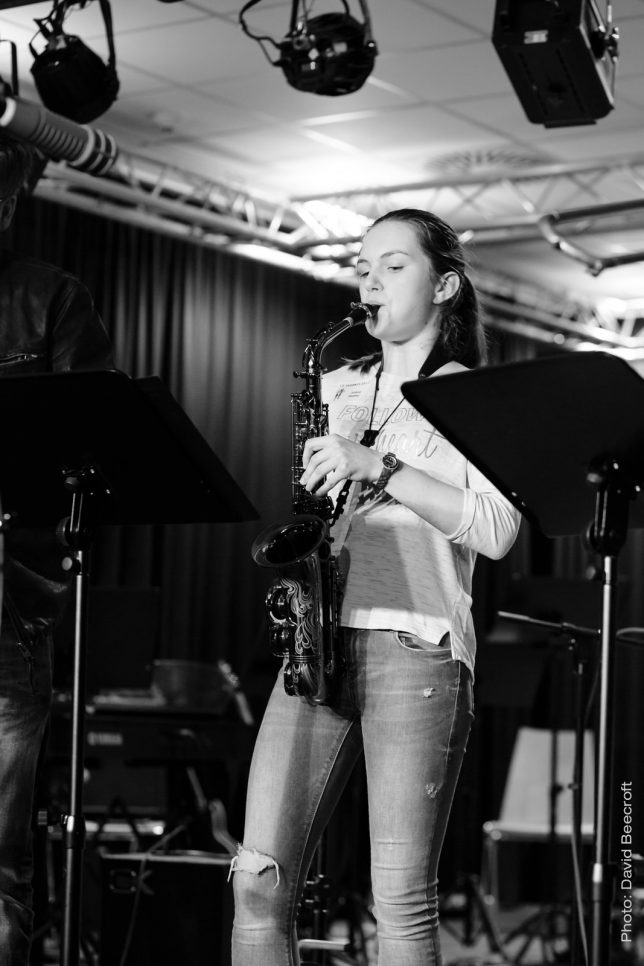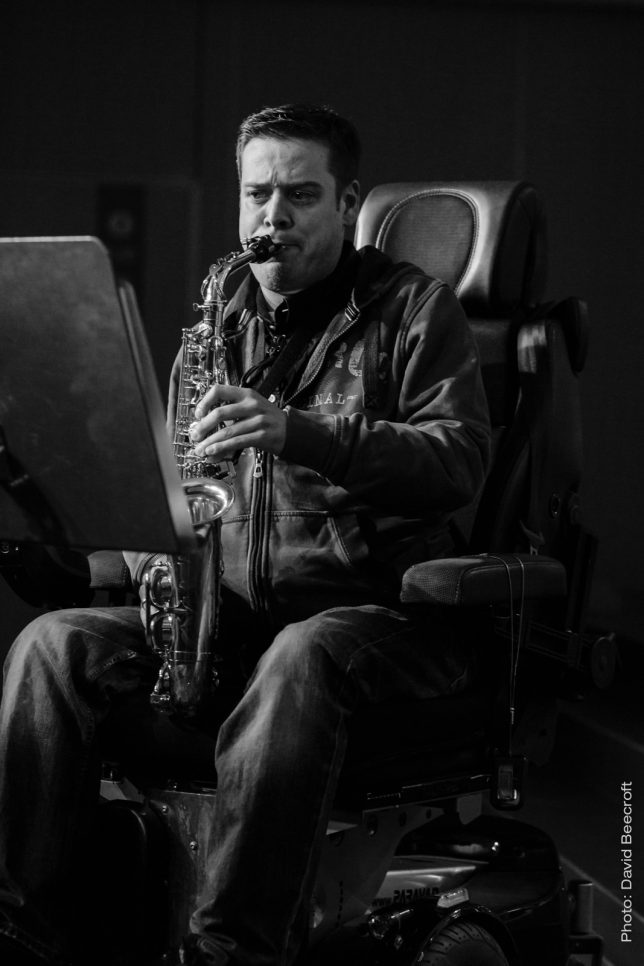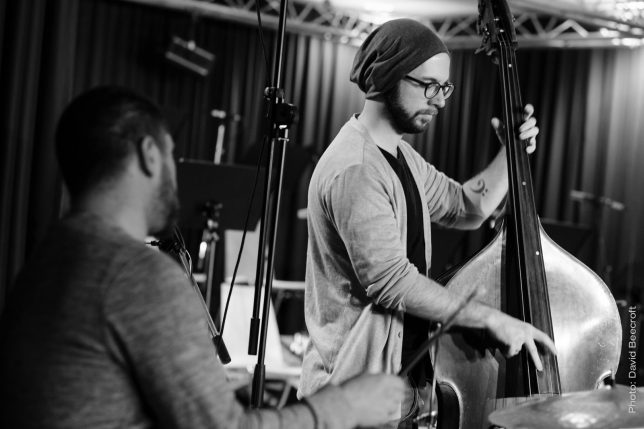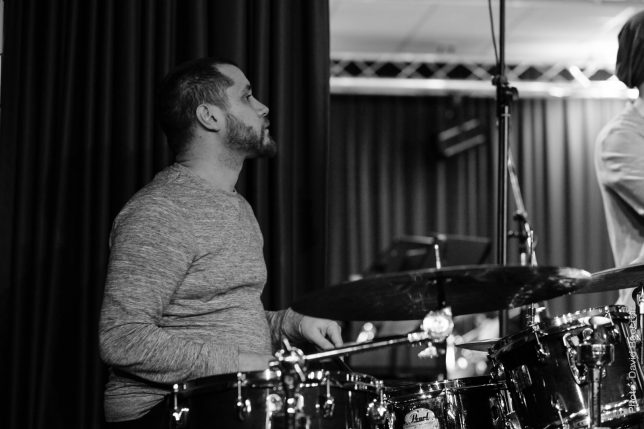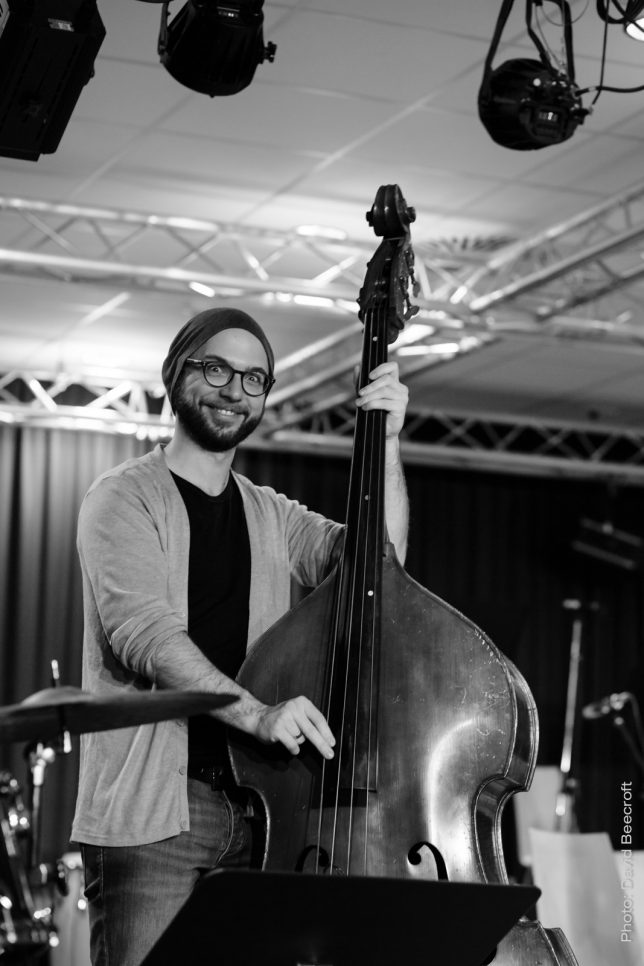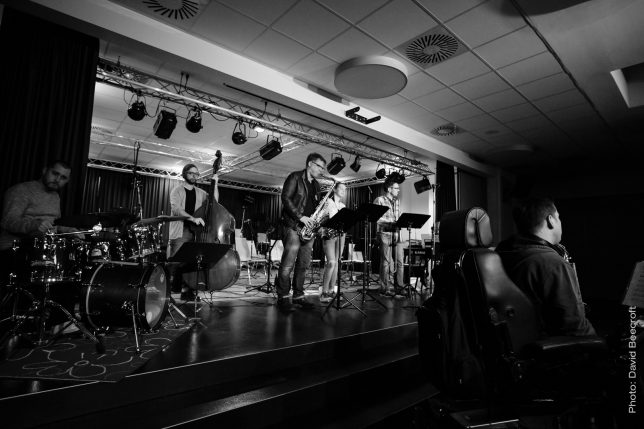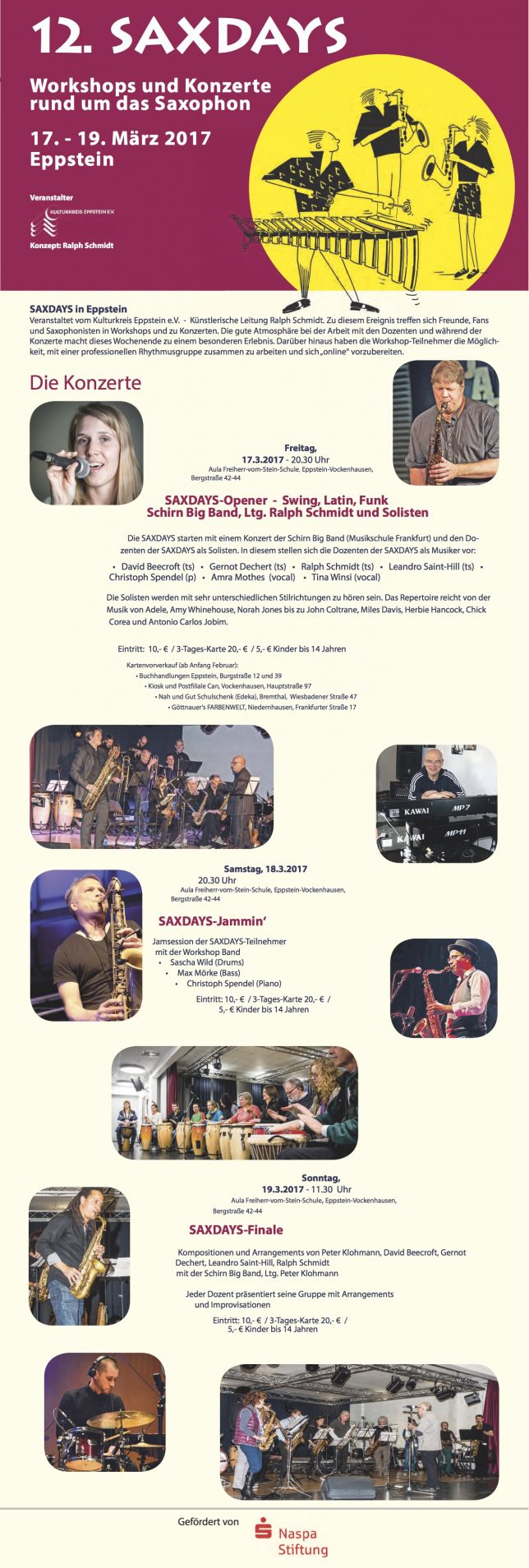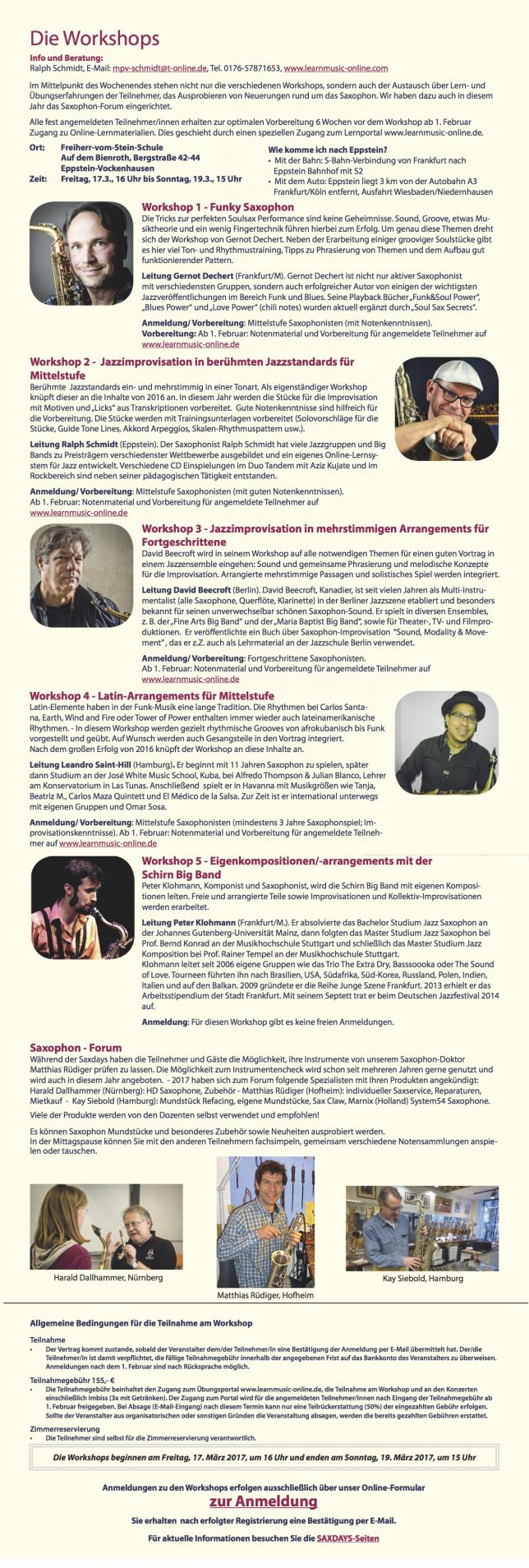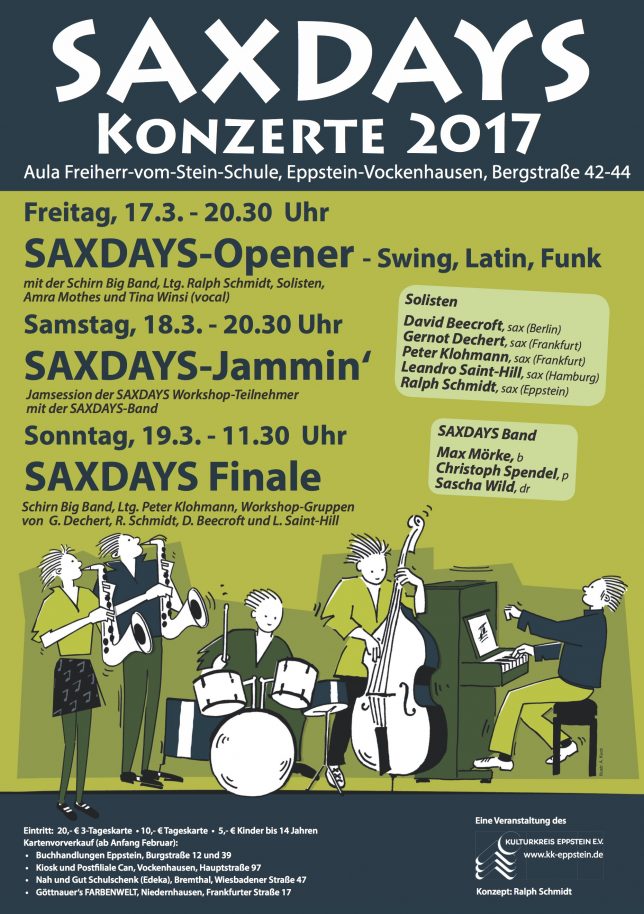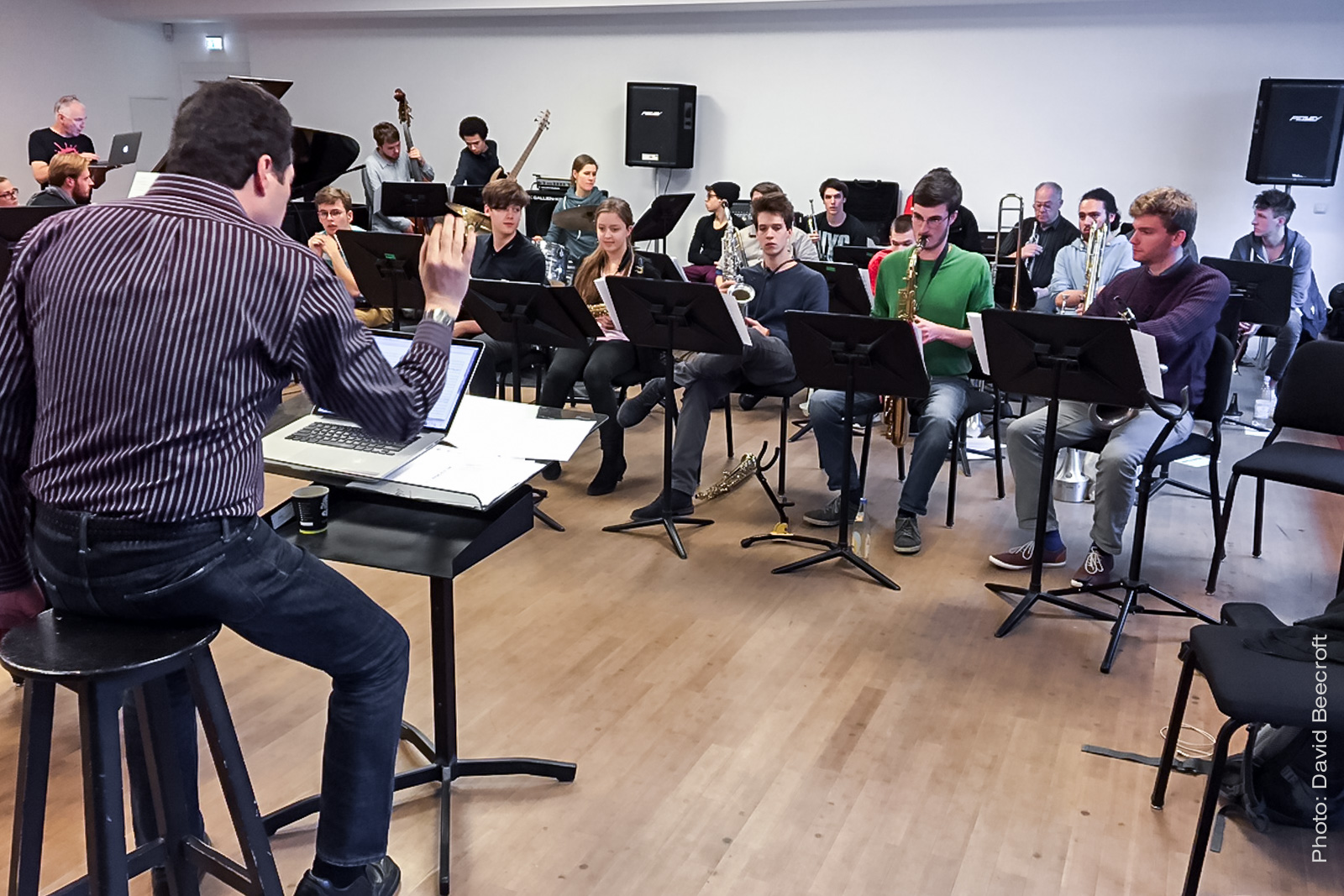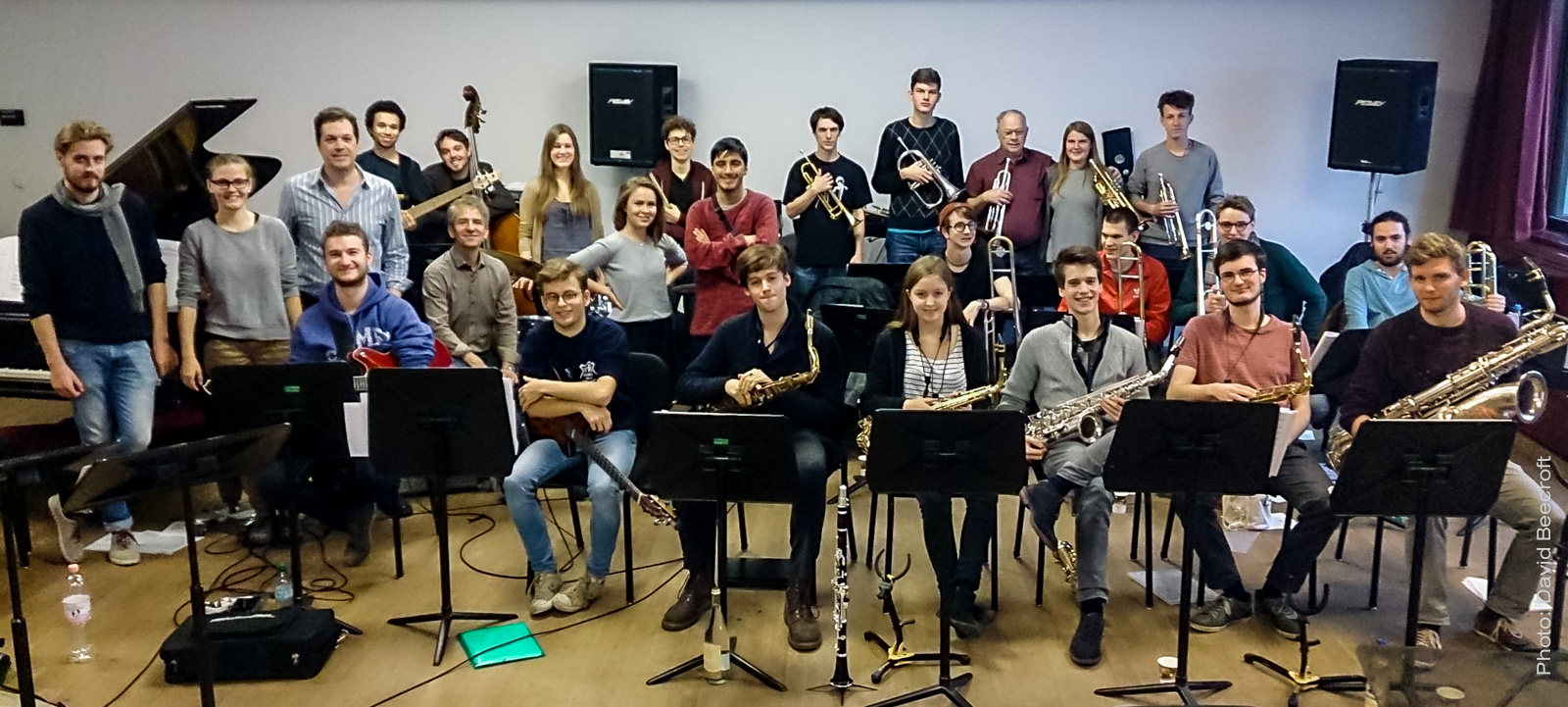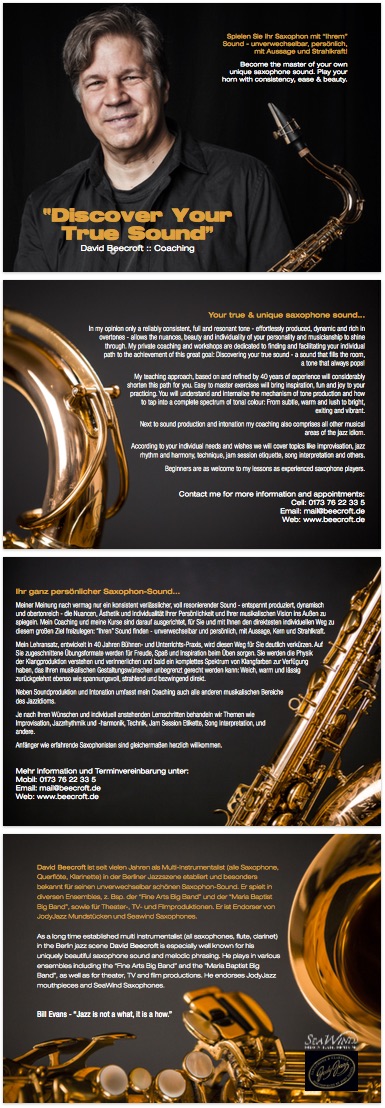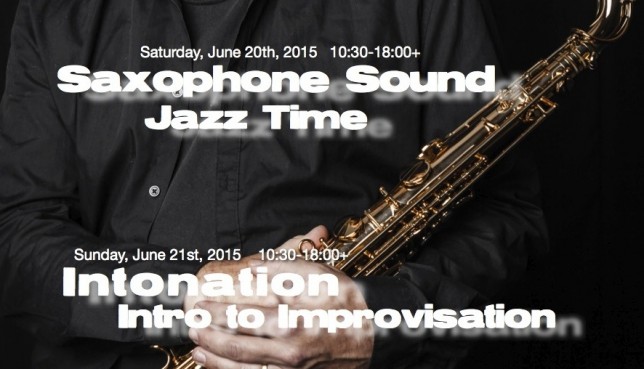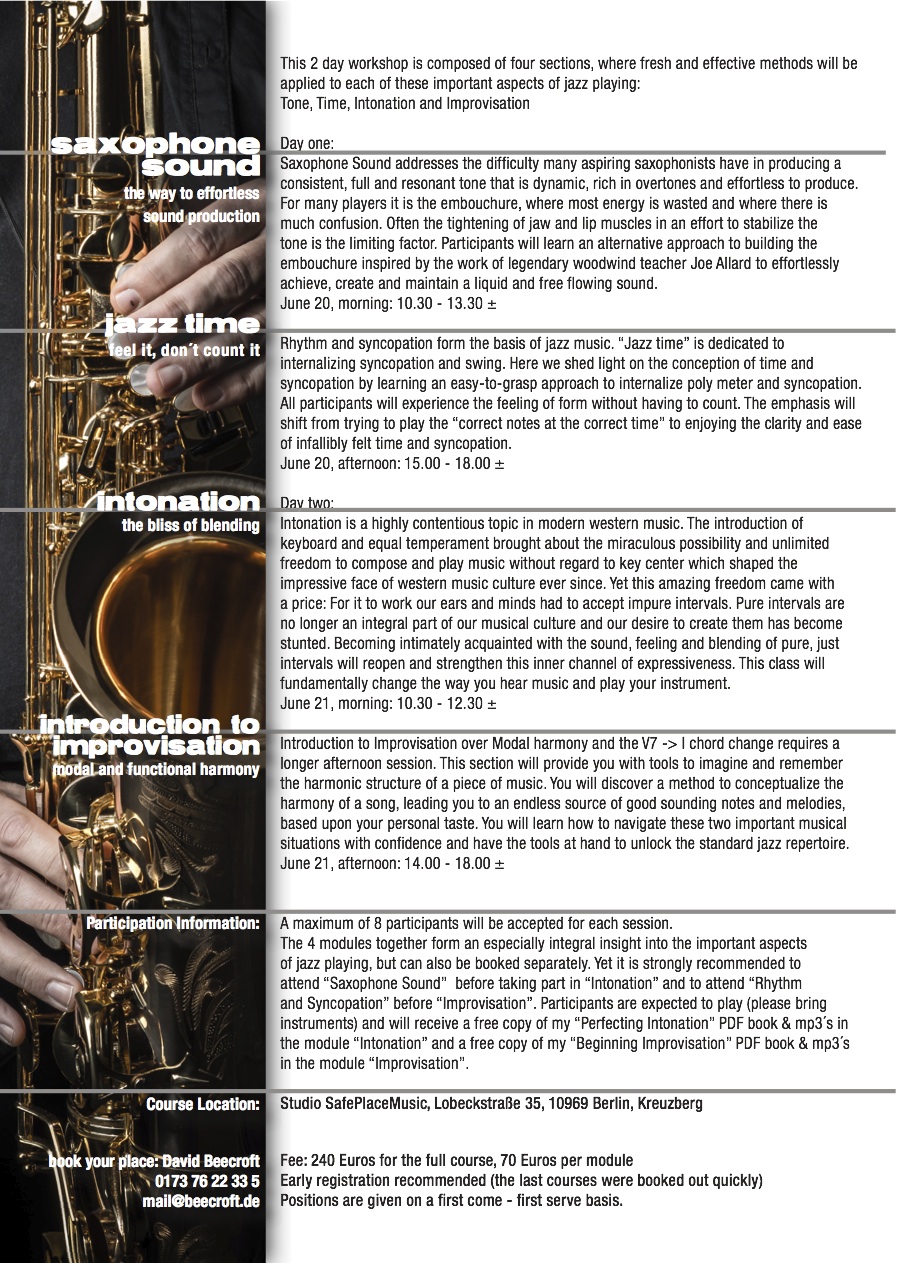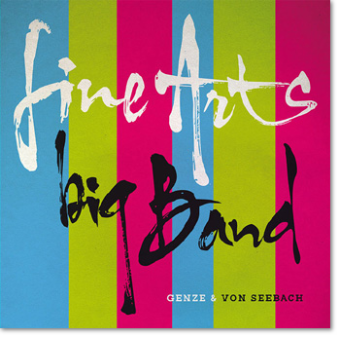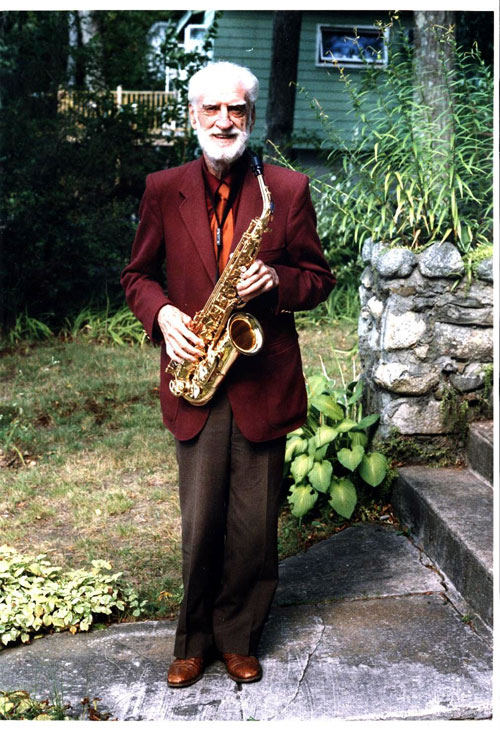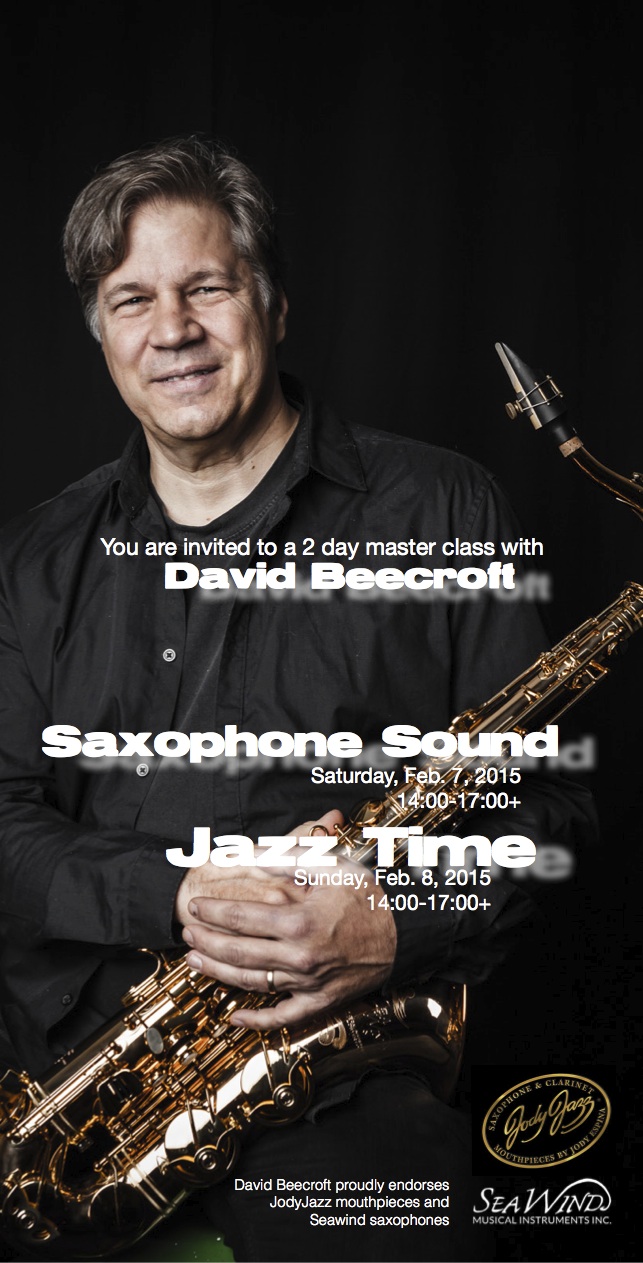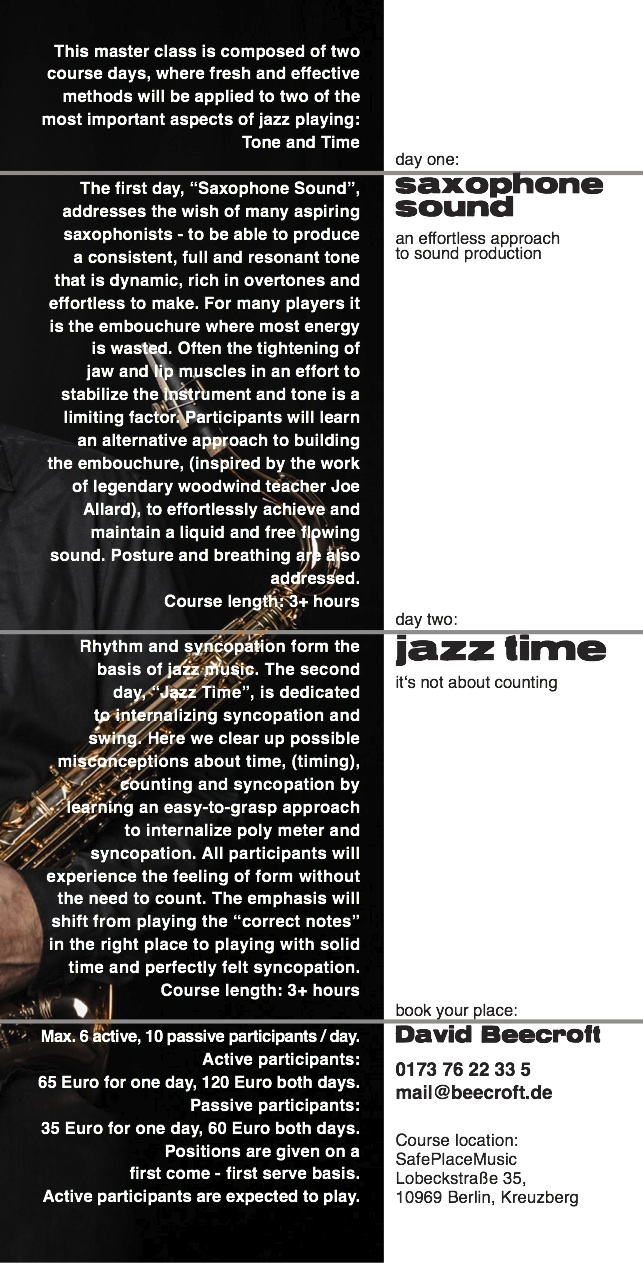Come Rain or Come Shine
Take that Covid19
I asked my daughter what I could do for her and her man as he, very recently, had a work related accident and is at home in recovery. He requested I make a version of “Take 5” for them to listen to. Well I guess being cooped up inside and practicing too much has had an influence on the way things turned out…
Workshop 3 David Beecroft – SaxDays – Eppstein
Dear saxophone students!
I will be teaching a workshop again this April 5, 6 & 7 – 2019 in Eppstein at the intensive saxophone workshop “SaxDays”. This is a great chance to work closely together with me on improvisation concepts and strategies. Not only will you be working together with a group of like minded saxophonists, you will be performing the pieces we will have worked on in frnt of an audience with a professional jazz rhythm section.
For more information about SaxDays and the online application form please follow this link: SaxDays.de
German text:
Strategien für die Improvisation über Jazzstandards
„Ballads and more“
Inhalte: Wie orientiere ich mich in einem Jazzstandard und den enthaltenen Akkordfolgen? An 2 Stücken werden verschiedene Strategien erarbeitet: Guide Tone Line, Spannung und Auflösung in Motiven, Sequenzbildung und stilbezogene Phrasierung, Melodielinien entwickeln. Als Ballade wird „Body and Soul“ auch in bekannten Solo Versionen in Transkriptionen analysiert.
Leitung David Beecroft (Berlin). Der Kanadier David Beecroft ist seit vielen Jahren als Multi-Instrumentalist (alle Saxophone, Querflöte, Klarinette) in der Berliner Jazzszene etabliert und besonders bekannt für seinen unverwechselbar schönen Saxophon-Sound. Er spielt in diversen Ensembles, z. B. der „Fine Arts Big Band“ und der „Maria Baptist Big Band“, sowie für Theater-, TV- und Filmproduktionen. Er veröffentlichte ein Buch über Saxophon-Improvisation “Sound, Modality & Movement” , das er z.Z. auch als Lehrmaterial an der Jazzschule Berlin verwendet.
Anmeldung/ Vorbereitung: Level C/D
Ab 1. Februar: Notenmaterial und Vorbereitung für angemeldete Teilnehmer auf www.learnmusic-online.de
Sing, touch, visualize & play
Sing, touch, visualize & play to learn the harmony and melodic possibilities the chords offer. This lesson requires that you sing, visualize the notes and their relationships to the chords and finger the horn.
Chord sequence for Bb horns:
Ab7 sus for 2 bars (Db major scale)
Bb7 sus for 2 bars (Eb major scale)
Db7 sus for 2 bars (Gb major scale)
C7 sus for 2 bars (F major scale)
SaxDays in Eppstein – A great place for safe sax…
Article in Wiesbadener Kurier:
INFO: Saxdays 2018
Die 13. Ausgabe der Eppsteiner Saxdays des Kulturkreis Eppstein soll im kommenden Jahr wieder entweder am letzten oder am vorletzten März-Wochenende statt finden. Auch im kommenden Jahr werden vier offene Workshops für jeweils maximal zwölf Teilnehmende angeboten. Die Teilnahme-Gebühr hat in diesem Jahr 155 Euro betragen. Anmeldungen werden ab September ausschließlich online möglich sein.
Weitere Informationen unter www.kulturkreis-eppstein.de sowie unter www.learnmusic-online.com
In Cahoots live from the Schlot Jazz Club Berlin
12. SAXDAYS in Eppstein-Vockenhausen
12. SAXDAYS in Eppstein-Vockenhausen. 17, 18, 19 of March 2017
I will be writing 3 saxophone specific pieces for this workshop and speaking about techniques for playing with a free blowing, relaxed sound and embouchure.
There will also be a section on meditation / breathing techniques to help you focus. These techniques help you play fearlessly and be “in the zone” every time.
Workshop pieces:
Candy
Hard March
Geru’s Blues (Gene Ammons)
Saxophone section coaching with Richard DeRosa and the Berliner Jugend Jazz Orchester
Berlin Jugend Big Band project with Richard DeRosa and other top musicians, Benjamin Strauss, David Beecroft, Greg Bowen, Simon Harrer, Martin Lillich.
We had an intense and exciting week learning and performing Richard DeRosa charts under his direction. It was a week of learning and growth. I can confirm that everything Mr DeRosa said was pure gold. A big thank you to the saxophone section for a great week.
Die Herbstarbeitsphase des BJJO findet vom 17. – 22. Oktober im FEZ Berlin statt und von dem Amerikanischen Komponisten und Dirigenten Richard DeRosa geleitet. Dabei werden seine eigenen Kompositionen im Vordergrund stehen.
DeRosa ist Leiter des Studiengangs Jazzkomposition und Arrangement an der University of North Texas und seit 2014 Chefdirigent der WDR Bigband Köln.
Recent Concerts in Prague with Guitarist Libor Šmoldas
I often play with players from other countries. We put together a program and make concerts mostly for the joy of playing together. One doesn’t usually get rich from playing. With music, especially these situations, the shared experience is very momentary. The audience may be tourists or some regular jazz club listeners. The four concerts we played were well attended but small venues and basically we were heard once in this formation and may not be heard again with this program or formation. What is it like to be in a new city, a place that is changing and growing? What is my impression of this experience? Can we as listeners and players hold onto this a little longer? Can we share it?
As well as being a saxophonist I am adept at recording and work as a photographer for other artists and companies. The following is an impression of the city of Prague and some of the music we played there.
https://soundcloud.com/beecroft/sets/too-late-now





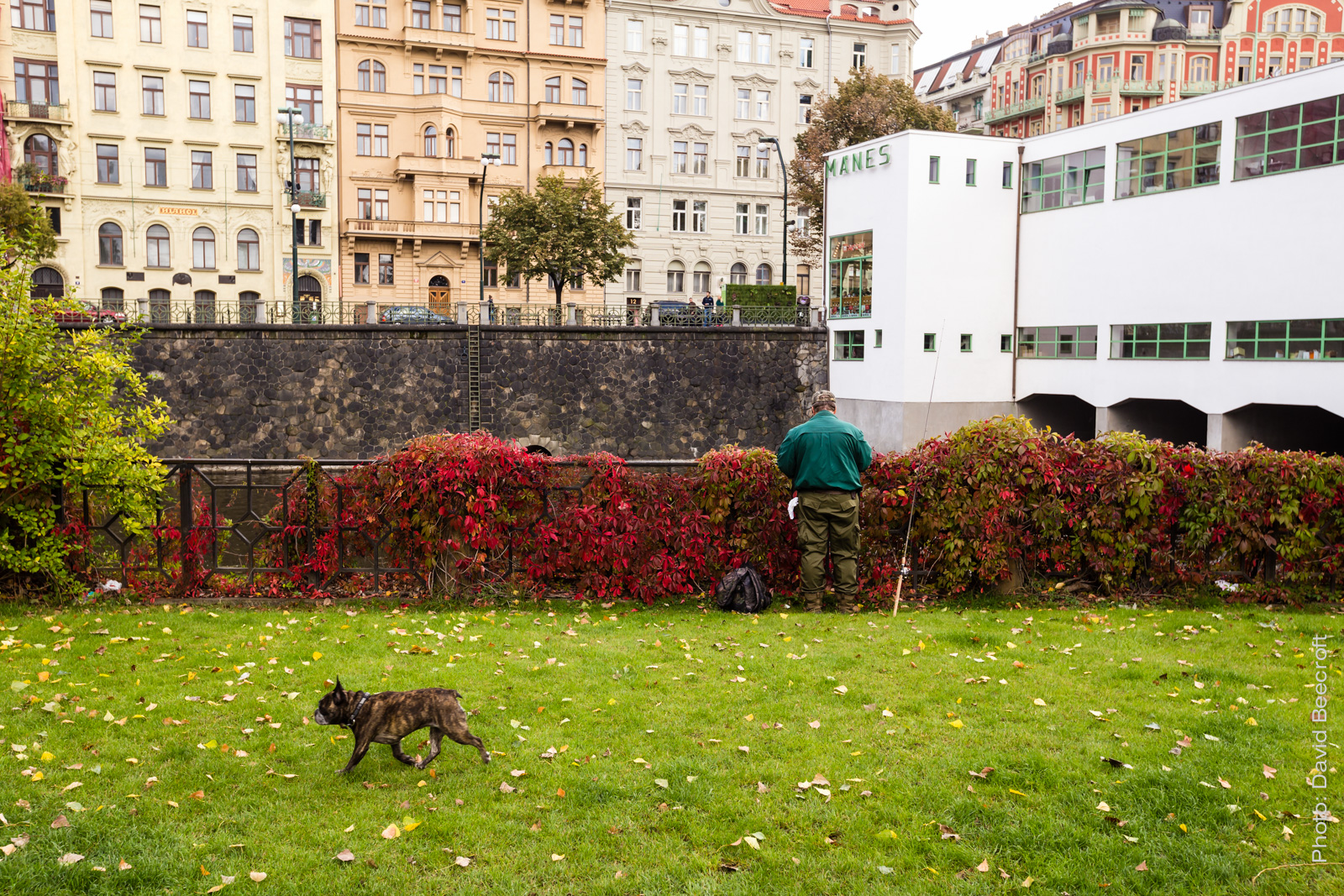

How About You
Discover Your True Sound
David Beecroft Sound Coaching for Saxophone
Spielen Sie Ihr Saxophon mit “Ihrem” Sound – unverwechselbar, persönlich, mit Aussage und Strahlkraft!
Become the master of your own unique saxophone sound. Play your horn with consistency, ease & beauty.
Two new little endorsement videos
Two new videos for JodyJazz and SeaWind:
2 Day Workshop with David Beecroft
This 2 day workshop is composed of four sections, where fresh and effective methods will be applied to each of these important aspects of jazz playing:
Tone, Time, Intonation and Improvisation
A maximum of 8 participants will be accepted for each session.
The 4 modules together form an especially integral insight into the important aspects
of jazz playing, but can also be booked separately.
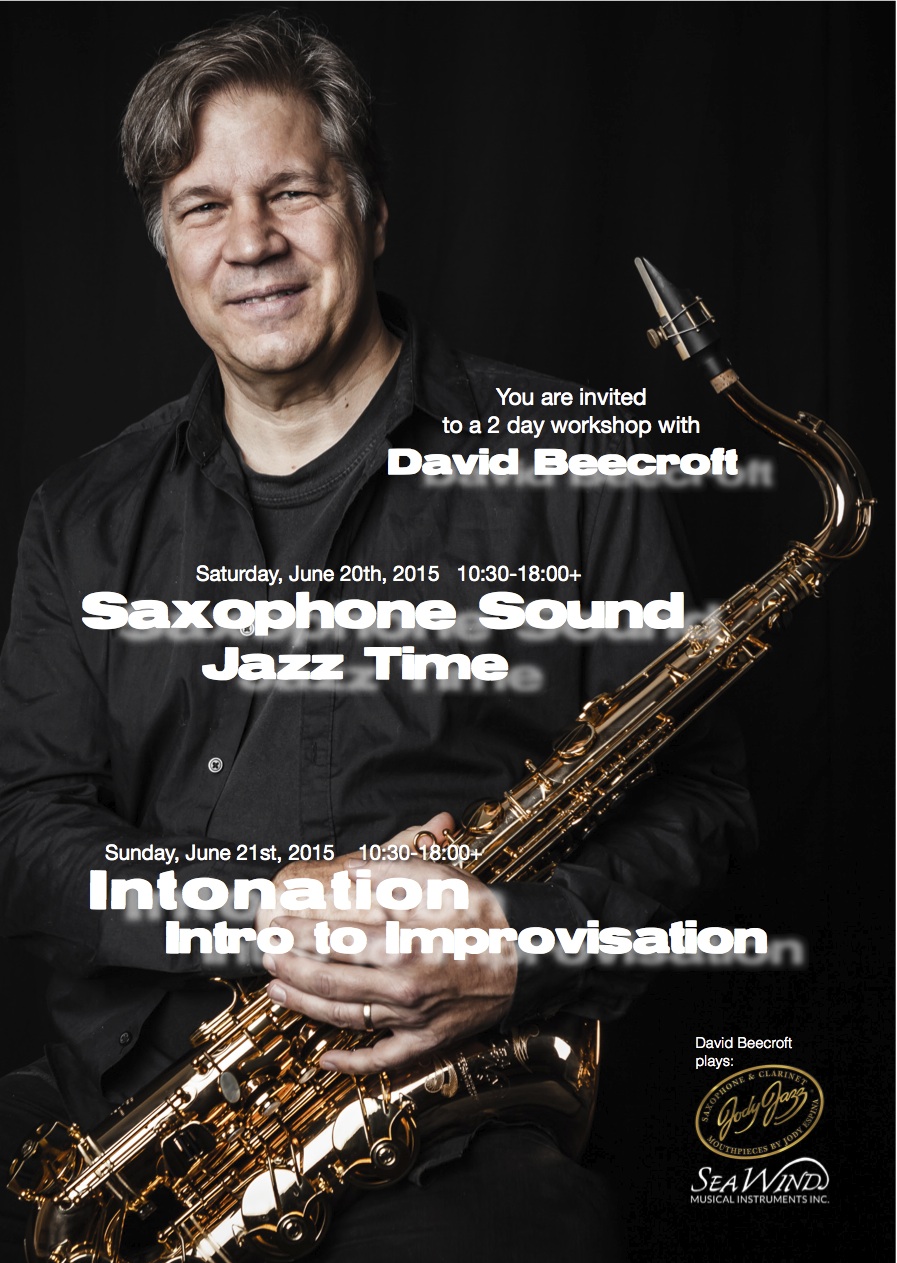
I will be performing with the great Phil Dwyer on the 8th and 9th of May with our “Seawind” quartet
The Seawind European Quartet plays “in the tradition” with drive, warmth and questionable Canadian humor. Long time Berlin resident and saxophone master David Beecroft will team up with Canadian jazz legend Phil Dwyer to create an evening of excitement, steeped in the tradition of the organ combo with a little “tenor battle” added to the mix, (David says Phil’s gonna win). Enjoy an evening of tenor saxophone blues, sumptuous ballads, exciting jam tunes and originals, all with a Canadian accent – eh.
Seawind European Quartet
Phil Dwyer – Tenor Saxophone
David Beecroft – Tenor Saxophone
Hal Tsuchida – Organ
Marcin Lonak – Drums
On Friday night only, a special guest appearance with Eric St-Laurent on Guitar!
We will be performing on the
8th of May in the Badenscher Hof
Badensche Straße 29, 10715
Reservations: 030 8610080
9th of May in the b-flat – Acoustic Musik & Jazz Club
Rosenthaler Straße 13, 10119
Reservations: 030 2833123
These will be exciting nights and I will be premiering 5 new pieces!
Come out to enjoy lots of exciting music.
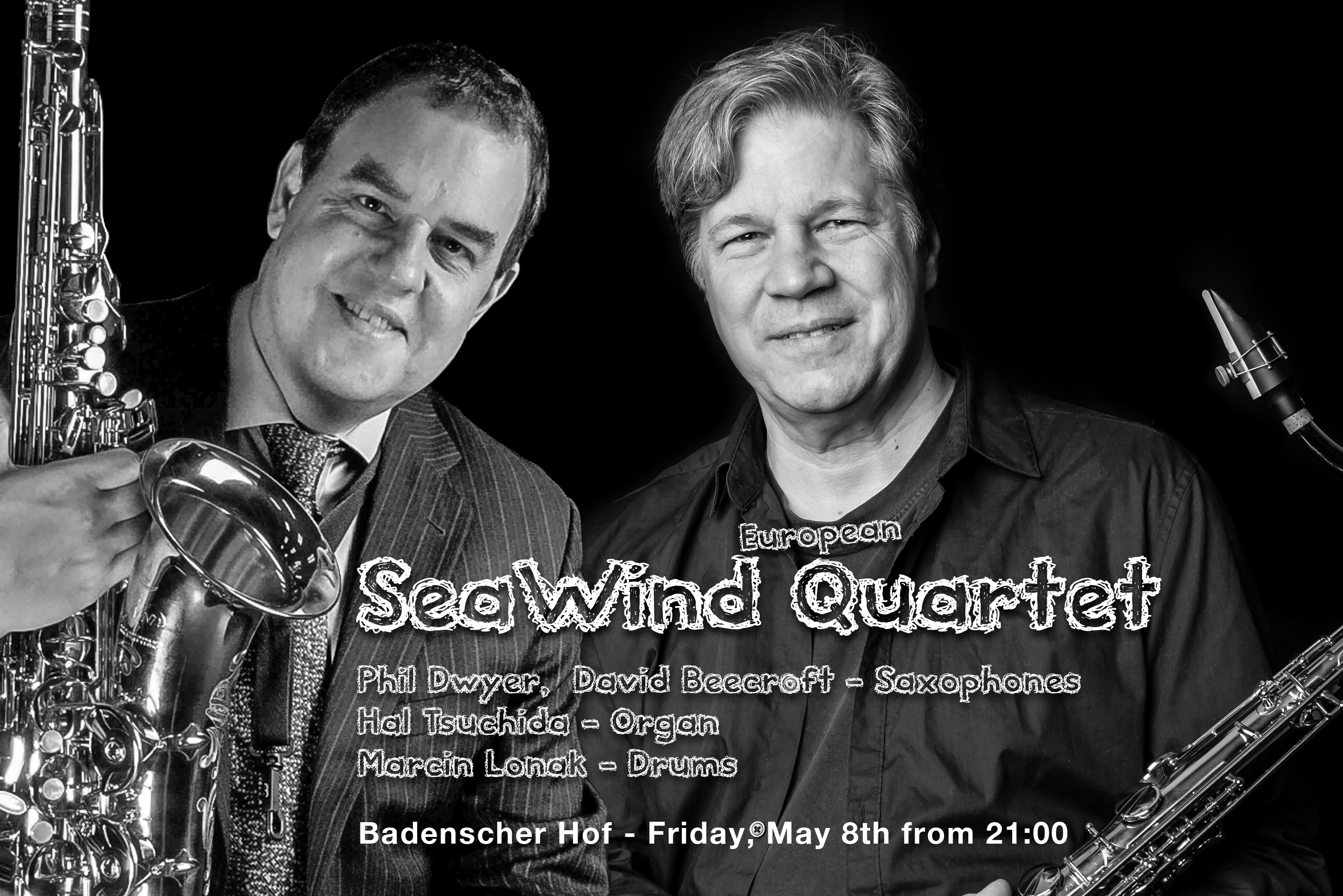
Dedicated to Fuasi Abdul-Khaliq and his speedy recovery!
Hey Fuasi, this is dedicated to you. May you be up and “Running with the Wind” as soon as possible!
Interview with Joe Allard about his saxophone concepts
Feedback from the Saxophone Sound & Jazz Time Masterclass
Thank you the participants of my masterclasses on sound and time. It was exhilarating and big fun!
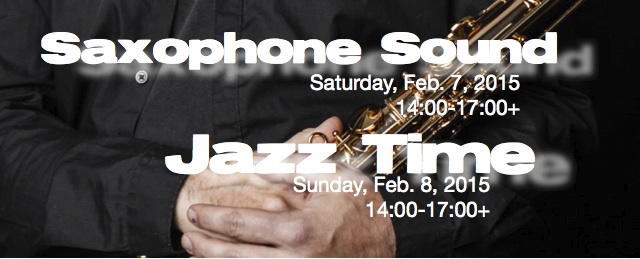
“David Beecroft is an excellent teacher – passionate, a true searcher, and both inspired and inspiring. I took a lot back home in this workshop, and I can recommend it to anyone who loves the saxophone and wants to take his playing further.” – Frederik S.
“Noten spielen , Musik machen….worin liegt der Unterschied? Durch Deinen workshop bin ich nun endlich dem Unterschied näher gekommen. Deine Rhythmusübungen und die Konzentration darauf über den Rhythmus die Musik in einer Komposition zu erfassen und auch zu erfühlen, bringt mich hier deutlich weiter. Danke dafür- und vor allem Danke auch für die tolle Atmosphäre die Du produzierst, damit jeder Lust und Laune hat, mit zu machen. Ich komme wieder und kann Deinen workshop jedem empfehlen, der mehr Musik aus dem Notenmaterial heraus holen möchte.” – Helmut E.
Children and the saxophone, a message to teachers…
Have you ever noticed that just because we know something is good or important for us it often doesn’t lead to actually doing something about it. Kids are like us but even more so. There is no you that knows what is best for you, this the grand illusion of consciousness. There is what you do and the quiet noise that exists between your ears.
A child wants to play, that’s why they sit there with an instrument in their hands.
No one is born knowing how to practice.
Practicing means to be ones own teacher.
With that said, when a child is at home they may have an urge to play w-i-t-h the saxophone. Everything that they actually do with the instrument after they open the case has to do with what they can immediately access from memories created in the lesson. Students don’t think in concepts like “long tones for tone” or “scales” or “arpeggios” or “excerpts” etc. These are names for things that one can already do. Learners need to be able to have at their fingertips a specific activity.
If the teacher works with a student on one thing for the whole lesson then boredom is sure to follow. Bored people don’t learn, they daydream or sleep. I did. Don’t think of it as “a person” learning, think of it as nerves, muscles and brain material learning. Those things learn best in the first few minutes when the activity is most difficult. They (the nerves, muscles and brain material) are no longer learning when it is easier. Repetition at this point is just ego having its moment. It also sends a strong message which is “I am great, don’t need to practice this, It’s practiced”
With memory there is no such thing as “burning it in” through repetition. What actually happens is that the student is burned out through long repetition, making it much harder to start again at home. The “burn in” comes through repeated accessing, which is a process of forgetting and remembering. This is how the brain decides which information should be shifted from short term to long term memory. It is the long term stuff that the child will practice. It is the long term stuff that the adult student will remember and play years later when they want to restart playing.
If you do at least four different things in rotation during the lesson it is actually practicing forgetting/remembering, or repeated accessing of the information. If the information is easier to access (because they have practiced this) then when the student goes home and opens the case (because they like the instrument), the first thing to do is already there as a clear physical/aural memory pulling them to play. No thinking about names or vague concepts that are supposed to be good and important, no reasoning, fighting, thinking, ignoring, just action.
There is a big gulf between a (vague) notion to practice “scales” and having ready access to an actual exercise that the hands and ears remember. These are two very different ways of knowing scales. “Think once, remember many” Your job is to think once and get the student to remember many – many times.
Fine Arts Big Band is on line
We played our first concert in the A-Trane on the 18th of January to two packed sets. All original music and arranging, and a band full of great soloists as well.
Visit the Fine Arts Big Band
or go directly to my behind the scenes photos.
Workshop on Saxophone Sound and Jazz Time is very full…
Just a reminder that the workshops for Saxophone Sound and Jazz Time on the weekend of the 7th and 8th of February are almost full, just one active place for Saxophone Sound and two places for Jazz Time are available. There are still places for passive participation available as well.
I am really looking forward to the workshop and have planned a few surprises…
David
Advice to a saxophone player…
Here is a little advice recently given to a saxophone player struggling with approach notes and II-7 V7 Imaj’s:
“I’m trying to get all of my 251s down with chromatic surrounds, but from the root, 3rd, 5th, and 7th. I’ve been practicing a lot but it doesn’t seem to be getting easier for me. Any suggestions?”
GC
If a progression is too difficult then break it down into something manageable. V7 -> I or just V7. Start by approaching the flat7 of the V chord with a rhythmic / syncopated idea.
Make music, not boring exercises.
When the 7th gets a bit easier then add an approach to the 3rd of the I chord. This is voice leading and is melodically strong.
Approach the 7th and then the 3rd of the V chord (or the 3rd and 7th) and then resolve to what sounds and feels right. If you touch the 3rd and 7th of the V7 chord anywhere in your line your ear will help you resolve. Everything will sound right.
Keep your “improvisations” within the range of a 5th or in just one area of the horn, this way you learn to play through the chords and not “up and down” the harmony.
It helps to sing a (syncopated and therefore musical) line and visualize the fingerings – even slightly move the fingers – in all keys. Sometimes play the notes to see if you are right in what you imagine and hear.
Sing (scat) a simple syncopated rhythmic idea and then add a few approach notes to the syncopations. If you don’t know any rhythmic ideas then listen to the older Basie recordings, they are full of great riffs. You can also check out the trombone parts in New Orleans marching bands, often referred to as the 2nd line. Steal the syncopations and add a few nice approach notes and chord tones.
Change keys every three minutes. Remember – you are practicing “the changes” – so start stringing chords together, practice changing. Follow the cycle C7 -> F7 -> Bb7 etc.
Use a simple set of changes – the A section of an easy standard – and spend 3 minutes in each key making music and finding the voice leading, the nice notes. Don’t worry if the first few times through the changes, especially in distant and unfamiliar keys, you don’t play anything cool. The nice voice leading notes will eventually come to you, usually when they are ready, after the 3rd or 4th time through the sequence. Be patient with the musician in you.
The tendency is to try and play all of the approach notes while practicing. Don’t. It isn’t musical and you would never actually solo that way. Simplify your playing. Practice ideas for shorter periods spaced over a longer time. It is better to come back to an idea three or four times in a practice session than obsess on it for thirty minutes in one shot.
Keep a log of what it is you are working on.
Now go practice – even though it’s Christmas.
D.
Joe Allard
Although I have never had the pleasure of meeting or studying with Joe Allard, I must admit that his concepts and methods have – through the media of video and antidote – influenced my approach to both learning and teaching to a very large degree. I highly recommend that any serious student of saxophone and clarinet investigate deeply the material to be found at the following addresses:
www.joeallard.org/pedagogy.html
It is my strong opinion that Mr. Allard expounds the most flexible and practical method of playing woodwind instruments to date, no matter what style one expresses ones self in. As always, anyone who is learning to play an instrument must adapt and make the information that they believe to be true their own. I think that, as a woodwind player, one should try to understand and put into practice that which Mr. Allard is demonstrating, (in the YouTube videos and links), to really be able to appreciate and decide whether the information is true for themselves or not. Personally, I think the method that Mr. Allard describes represents the state of the art of modern woodwind playing.
Jazz Sound and Jazz Time – Workshop
2 day Master class on Saxophone Sound and Jazz Time – this February
This master class is composed of two course days, where fresh and effective methods will be applied to two of the most important aspects of jazz playing:
Tone and Time
The first day, “Saxophone Sound”, addresses the wish of many aspiring saxophonists – to be able to produce a consistent, full and resonant tone that is dynamic, rich in overtones and effortless to make. For many players it is the embouchure where most energy is wasted. Often the tightening of jaw and lip muscles in an effort to stabilize the instrument and tone is a limiting factor. Participants will learn an alternative approach to building the embouchure, (inspired by the work of legendary woodwind teacher Joe Allard), to effortlessly achieve and maintain a liquid and free flowing sound. Posture and breathing are also addressed.
Course length: 3+ hours
Rhythm and syncopation form the basis of jazz music. The second day, “Jazz Time”, is dedicated to internalizing syncopation and swing. Here we clear up possible misconceptions about time, (timing), counting and syncopation by learning an easy-to-grasp approach to internalize poly meter and syncopation. All participants will experience the feeling of form without the need to count. The emphasis will shift from playing the “correct notes” in the right place to playing with solid time and perfectly felt syncopation.
Course length: 3+ hours
Max. 6 active, 10 passive participants / day.
Active participants:
65 Euro for one day, 120 Euro both days.
Passive participants:
35 Euro for one day, 60 Euro both days. Positions are given on a
first come – first serve basis.
Active participants are expected to play.
Coming in spring:
A 2 day master class on Jazz Ear-Training and Jazz Improvisation
Day one:
Ear training method based upon natural tuning – intervals and scales. We will be exploring singing and playing along with specially developed play-alongs that present 12 pure (natural tuning as opposed to equal tempered tuning) intervals occurring within one octave. With these interval play-alongs we will learn to sing and hear the basic tonal building blocks of jazz improvisation.
3 + hours
Day 2:
Modes and Harmonic Function (V7 -> I) Two approaches to improvisation. The student is presented with a way to internalize and improvise over the most common modes used in jazz – with out an excessive dependence upon thinking while playing. Additionally the student will be presented with an approach for internalizing the most important harmonic function found in the standard song harmony – the V7 -> I progression, in Major and Minor keys.
3 + hours
Please feel free to contact me for details
mail AT beecroft DOT de
